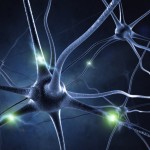How are Neurons Different with ASD?
 Most evidence suggests that autism results from altered connections between neurons called synapses. Major current synaptic theories of autism include the following:
Most evidence suggests that autism results from altered connections between neurons called synapses. Major current synaptic theories of autism include the following:
1. Activity-dependent synaptic plasticity. Because children with Autism Spectrum Disorder (ASD) suffer from deficits in learning how to engage socially with others as well as language issues, one idea is that autism reflects problems with activity-dependent synaptic changes.1 As discussed in the “How Experience Changes the Brain” section, the experience gained from learning leads to activity-dependent change at the synapse. Activity-dependent means that the change requires the neuron to be active, sending nerve impulses to its connecting neurons. Scientists have genetic evidence for this theory.
2. Synaptic Pruning. The enlarged brain seen in young children with ASD suggests a lack of synaptic pruning, or shaping, of connections. In other words, the neurons receive more inputs than typical. A lack of pruning affects a synapse’s efficiency in reacting to a given stimulus, which can affect neurons in a variety of ways, including how efficient and focused we are when paying attention to a particular task or person.
3. Balance of Excitatory and Inhibitory Synapses2. One way the brain helps us focus on a task is with inhibitory neurons, which contain the neurotransmitter GABA (short for gamma-amino butyric acid). Inhibition can sharpen an excitatory neuron’s response to an input. If an excitatory neuron’s activity is not controlled, it can actually die, through a process called excitotoxicity. Scientists can observe levels of activity in the brain with electroencephalograms (EEGs), through the technique of placing electrodes on the scalp. Up to 65% of patients with ASD show abnormal EEG activity. This suggests that the ratio of excitation to inhibition in children with autism may differ from that in neurotypical children. Like other theories, genetic evidence supports this idea.2
Changes in levels of excitation and inhibition may affect brain waves, or brain oscillations. Although scientists have long used the electrical activity that can be captured with electrodes on the scalp to study sensory processing and attention, they didn’t fully understand what this activity meant. Now we know that these waves, or brain oscillations, reflect the summed-up, or synchronous, activity of particular neural circuits. In a way, these oscillations provide a link between a single neuron’s activity and the behavior that we observe. Deficits in auditory and visual brain waves, or evoked potentials, in people with ASD suggest problems in information processing. Deficits in a particularly famous brain wave called the P300 (because it is seen 300 milliseconds after a stimulus occurs) suggest problems in selective attention.3 Children with autism also show abnormalities in a particular type of wave seen in EEGs called a gamma wave, and the difference is correlated, or linked, with IQ.4
| References: |
|

